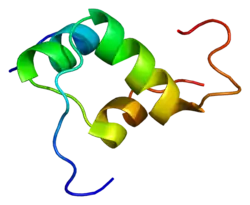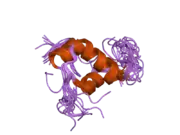| INSL3 | |||||||||||||||||||||||||||||||||||||||||||||||||||
|---|---|---|---|---|---|---|---|---|---|---|---|---|---|---|---|---|---|---|---|---|---|---|---|---|---|---|---|---|---|---|---|---|---|---|---|---|---|---|---|---|---|---|---|---|---|---|---|---|---|---|---|
 | |||||||||||||||||||||||||||||||||||||||||||||||||||
| |||||||||||||||||||||||||||||||||||||||||||||||||||
| Identifiers | |||||||||||||||||||||||||||||||||||||||||||||||||||
| Aliases | INSL3, RLF, RLNL, ley-I-L, insulin like 3 | ||||||||||||||||||||||||||||||||||||||||||||||||||
| External IDs | OMIM: 146738 MGI: 108427 HomoloGene: 4048 GeneCards: INSL3 | ||||||||||||||||||||||||||||||||||||||||||||||||||
| |||||||||||||||||||||||||||||||||||||||||||||||||||
| |||||||||||||||||||||||||||||||||||||||||||||||||||
| |||||||||||||||||||||||||||||||||||||||||||||||||||
| |||||||||||||||||||||||||||||||||||||||||||||||||||
| |||||||||||||||||||||||||||||||||||||||||||||||||||
| Wikidata | |||||||||||||||||||||||||||||||||||||||||||||||||||
| |||||||||||||||||||||||||||||||||||||||||||||||||||
Insulin-like 3 is a protein that in humans is encoded by the INSL3 gene.[5][6]
Function
The protein encoded by this gene is an insulin like hormone produced mainly in gonadal tissues in males and females. Studies of the mouse counterpart suggest that this gene may be involved in the development of urogenital tract and female fertility. INSL-3 initiates meiotic progression in follicle-enclosed oocytes by mediating a reduction in intra-oocyte cAMP concentration by activating leucine-rich repeat-containing G protein-coupled receptor 8 (LGR8).[7] It may also act as a hormone to regulate growth and differentiation of gubernaculum, and thus mediating intra-abdominal testicular descent. The mutations in this gene may lead to, but not a frequent cause of, cryptorchidism.[6]
References
- 1 2 3 GRCh38: Ensembl release 89: ENSG00000248099 - Ensembl, May 2017
- 1 2 3 GRCm38: Ensembl release 89: ENSMUSG00000079019 - Ensembl, May 2017
- ↑ "Human PubMed Reference:". National Center for Biotechnology Information, U.S. National Library of Medicine.
- ↑ "Mouse PubMed Reference:". National Center for Biotechnology Information, U.S. National Library of Medicine.
- ↑ Burkhardt E, Adham IM, Brosig B, Gastmann A, Mattei MG, Engel W (March 1994). "Structural organization of the porcine and human genes coding for a Leydig cell-specific insulin-like peptide (LEY I-L) and chromosomal localization of the human gene (INSL3)". Genomics. 20 (1): 13–9. doi:10.1006/geno.1994.1121. PMID 8020942.
- 1 2 "Entrez Gene: INSL3 insulin-like 3 (Leydig cell)".
- ↑ Richard FJ (March 2007). "Regulation of meiotic maturation". Journal of Animal Science. 85 (13 Suppl): E4-6. doi:10.2527/jas.2006-475. PMID 17040950.
Further reading
- Lai KS, Jin Y, Graham DK, Witthuhn BA, Ihle JN, Liu ET (October 1995). "A kinase-deficient splice variant of the human JAK3 is expressed in hematopoietic and epithelial cancer cells". The Journal of Biological Chemistry. 270 (42): 25028–36. doi:10.1074/jbc.270.42.25028. PMID 7559633.
- Macchi P, Villa A, Giliani S, Sacco MG, Frattini A, Porta F, Ugazio AG, Johnston JA, Candotti F, O'Shea JJ (September 1995). "Mutations of Jak-3 gene in patients with autosomal severe combined immune deficiency (SCID)". Nature. 377 (6544): 65–8. Bibcode:1995Natur.377...65M. doi:10.1038/377065a0. PMID 7659163. S2CID 4329874.
- Tashima LS, Hieber AD, Greenwood FC, Bryant-Greenwood GD (February 1995). "The human Leydig insulin-like (hLEY I-L) gene is expressed in the corpus luteum and trophoblast". The Journal of Clinical Endocrinology and Metabolism. 80 (2): 707–10. doi:10.1210/jcem.80.2.7852540. PMID 7852540.
- Witthuhn BA, Silvennoinen O, Miura O, Lai KS, Cwik C, Liu ET, Ihle JN (July 1994). "Involvement of the Jak-3 Janus kinase in signalling by interleukins 2 and 4 in lymphoid and myeloid cells". Nature. 370 (6485): 153–7. Bibcode:1994Natur.370..153W. doi:10.1038/370153a0. PMID 8022486. S2CID 11711979.
- Kawamura M, McVicar DW, Johnston JA, Blake TB, Chen YQ, Lal BK, Lloyd AR, Kelvin DJ, Staples JE, Ortaldo JR (July 1994). "Molecular cloning of L-JAK, a Janus family protein-tyrosine kinase expressed in natural killer cells and activated leukocytes". Proceedings of the National Academy of Sciences of the United States of America. 91 (14): 6374–8. Bibcode:1994PNAS...91.6374K. doi:10.1073/pnas.91.14.6374. PMC 44204. PMID 8022790.
- Burkhardt E, Adham IM, Hobohm U, Murphy D, Sander C, Engel W (July 1994). "A human cDNA coding for the Leydig insulin-like peptide (Ley I-L)". Human Genetics. 94 (1): 91–4. doi:10.1007/BF02272850. PMID 8034302. S2CID 11255499.
- Adham IM, Burkhardt E, Benahmed M, Engel W (December 1993). "Cloning of a cDNA for a novel insulin-like peptide of the testicular Leydig cells". The Journal of Biological Chemistry. 268 (35): 26668–72. doi:10.1016/S0021-9258(19)74364-6. PMID 8253799.
- Verbsky JW, Bach EA, Fang YF, Yang L, Randolph DA, Fields LE (June 1996). "Expression of Janus kinase 3 in human endothelial and other non-lymphoid and non-myeloid cells". The Journal of Biological Chemistry. 271 (24): 13976–80. doi:10.1074/jbc.271.24.13976. PMID 8662778.
- Candotti F, Oakes SA, Johnston JA, Giliani S, Schumacher RF, Mella P, Fiorini M, Ugazio AG, Badolato R, Notarangelo LD, Bozzi F, Macchi P, Strina D, Vezzoni P, Blaese RM, O'Shea JJ, Villa A (November 1997). "Structural and functional basis for JAK3-deficient severe combined immunodeficiency". Blood. 90 (10): 3996–4003. doi:10.1182/blood.V90.10.3996. PMID 9354668.
- Bozzi F, Lefranc G, Villa A, Badolato R, Schumacher RF, Khalil G, Loiselet J, Bresciani S, O'Shea JJ, Vezzoni P, Notarangelo LD, Candotti F (September 1998). "Molecular and biochemical characterization of JAK3 deficiency in a patient with severe combined immunodeficiency over 20 years after bone marrow transplantation: implications for treatment". British Journal of Haematology. 102 (5): 1363–6. doi:10.1111/j.1365-2141.1998.tb08990.x. PMID 9753072. S2CID 31606560.
- Nef S, Parada LF (July 1999). "Cryptorchidism in mice mutant for Insl3". Nature Genetics. 22 (3): 295–9. doi:10.1038/10364. PMID 10391220. S2CID 1394181.
- Büllesbach EE, Rhodes R, Rembiesa B, Schwabe C (April 1999). "The relaxin-like factor is a hormone". Endocrine. 10 (2): 167–9. doi:10.1385/ENDO:10:2:167. PMID 10451226. S2CID 27433286.
- Krausz C, Quintana-Murci L, Fellous M, Siffroi JP, McElreavey K (April 2000). "Absence of mutations involving the INSL3 gene in human idiopathic cryptorchidism". Molecular Human Reproduction. 6 (4): 298–302. doi:10.1093/molehr/6.4.298. PMID 10729310.
- Koskimies P, Virtanen H, Lindström M, Kaleva M, Poutanen M, Huhtaniemi I, Toppari J (April 2000). "A common polymorphism in the human relaxin-like factor (RLF) gene: no relationship with cryptorchidism". Pediatric Research. 47 (4 Pt 1): 538–41. doi:10.1203/00006450-200004000-00020. PMID 10759163.
- Endo K, Takeshita T, Kasai H, Sasaki Y, Tanaka N, Asao H, Kikuchi K, Yamada M, Chenb M, O'Shea JJ, Sugamura K (July 2000). "STAM2, a new member of the STAM family, binding to the Janus kinases". FEBS Letters. 477 (1–2): 55–61. doi:10.1016/S0014-5793(00)01760-9. PMID 10899310. S2CID 31811757.
- Schumacher RF, Mella P, Badolato R, Fiorini M, Savoldi G, Giliani S, Villa A, Candotti F, Tampalini A, O'Shea JJ, Notarangelo LD (January 2000). "Complete genomic organization of the human JAK3 gene and mutation analysis in severe combined immunodeficiency by single-strand conformation polymorphism". Human Genetics. 106 (1): 73–9. doi:10.1007/s004390051012. PMID 10982185.
- Tomboc M, Lee PA, Mitwally MF, Schneck FX, Bellinger M, Witchel SF (November 2000). "Insulin-like 3/relaxin-like factor gene mutations are associated with cryptorchidism". The Journal of Clinical Endocrinology and Metabolism. 85 (11): 4013–8. doi:10.1210/jcem.85.11.6935. PMID 11095425.
- Hombach-Klonisch S, Buchmann J, Sarun S, Fischer B, Klonisch T (December 2000). "Relaxin-like factor (RLF) is differentially expressed in the normal and neoplastic human mammary gland". Cancer. 89 (11): 2161–8. doi:10.1002/1097-0142(20001201)89:11<2161::AID-CNCR3>3.0.CO;2-K. PMID 11147585.
- Lim HN, Raipert-de Meyts E, Skakkebaek NE, Hawkins JR, Hughes IA (February 2001). "Genetic analysis of the INSL3 gene in patients with maldescent of the testis". European Journal of Endocrinology. 144 (2): 129–37. doi:10.1530/eje.0.1440129. PMID 11182749.




